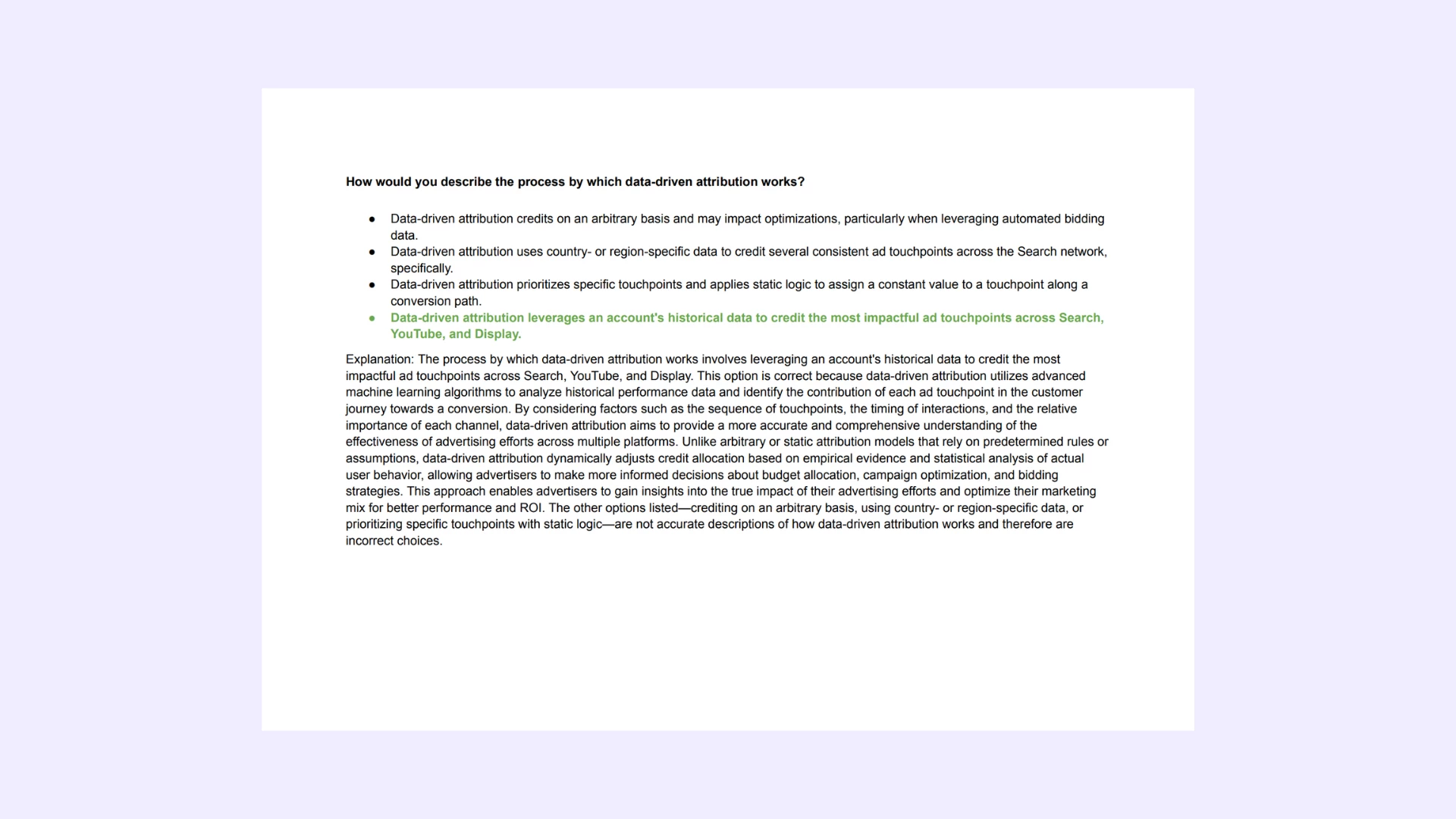How would you describe the process by which data-driven attribution works?
Data-driven attribution credits on an arbitrary basis and may impact optimizations, particularly when leveraging automated bidding data.
Data-driven attribution uses country- or region-specific data to credit several consistent ad touchpoints across the Search network, specifically.
Data-driven attribution prioritizes specific touchpoints and applies static logic to assign a constant value to a touchpoint along a conversion path.
Data-driven attribution leverages an account's historical data to credit the most impactful ad touchpoints across Search, YouTube, and Display.
Choose an option to see if it’s correct. Check the explanation and practical tips below. Learn Smarter, not Harder.
This question is one of Google Ads measurement asessment questions. You could consult all exam answers here - Google Ads Measurement Certification Exam Answers
Want to Earn All Google Ads Certifications in No Time?
Then check out our exclusive 👉 Google Ads Roll Offer! This comprehensive package includes questions, answers, and detailed explanations for each Google Ads certification. Get everything you need to achieve success faster.
Explanation: How would you describe the process by which data-driven attribution works?
In Short: The process by which data-driven attribution works involves leveraging an account's historical data to credit the most impactful ad touchpoints across Search, YouTube, and Display. This option is correct because data-driven attribution utilizes advanced machine learning algorithms to analyze historical performance data and identify the contribution of each ad touchpoint in the customer journey towards a conversion. By considering factors such as the sequence of touchpoints, the timing of interactions, and the relative importance of each channel, data-driven attribution aims to provide a more accurate and comprehensive understanding of the effectiveness of advertising efforts across multiple platforms. Unlike arbitrary or static attribution models that rely on predetermined rules or assumptions, data-driven attribution dynamically adjusts credit allocation based on empirical evidence and statistical analysis of actual user behavior, allowing advertisers to make more informed decisions about budget allocation, campaign optimization, and bidding strategies. This approach enables advertisers to gain insights into the true impact of their advertising efforts and optimize their marketing mix for better performance and ROI. The other options listed—crediting on an arbitrary basis, using country- or region-specific data, or prioritizing specific touchpoints with static logic—are not accurate descriptions of how data-driven attribution works and therefore are incorrect choices.

Google Ads Roll. Special Offer.
Note: We conduct daily checks for updates on the exam, ensuring that the file contains the most recent questions from the actual certification program.
Questions | Answers | Explanations. FREE Updates.
In Details: How would you describe the process by which data-driven attribution works?
Practical Use Case:
Let’s say you’re managing a digital marketing campaign for an e-commerce company that uses Google Ads across various platforms, including Search, YouTube, and Display Network. You’ve been tasked with understanding how users interact with your ads across these touchpoints and how each interaction contributes to conversions, whether it’s a purchase or a sign-up.

Using data-driven attribution, you can track each customer’s journey and understand how each touchpoint—whether they clicked on a search ad, watched a YouTube video ad, or saw a display ad—impacts their decision to convert. By leveraging your account’s historical data, Google Ads assigns credit to the most impactful touchpoints along the customer’s path to conversion, offering a more accurate view of the customer journey than traditional models like last-click attribution.
For example, if a user first sees a Display ad, then interacts with a Search ad before completing a purchase, data-driven attribution helps determine the weight of each touchpoint based on its historical effectiveness, providing you with better insights to optimize your future campaigns.
Insights & Tips:
-
Leverage Historical Data: Data-driven attribution is based on historical performance data, meaning it gets smarter over time as it learns which touchpoints are most likely to lead to conversions. The more data you have, the more accurate the attribution model will become. This helps you make data-backed decisions rather than relying on arbitrary assumptions.
-
Better Campaign Optimization: With data-driven attribution, you get a clear understanding of which channels or touchpoints are driving the most conversions. For example, you might find that YouTube video ads have a significant impact earlier in the funnel, while Search ads are more effective closer to conversion. With this knowledge, you can allocate your budget more effectively.
-
Avoid Static Logic: Unlike traditional attribution models that assign a constant value to each touchpoint (such as first-click or last-click models), data-driven attribution adapts based on real data. This adaptability ensures you’re optimizing for the most relevant touchpoints in real-time.
Tip: If you’re new to data-driven attribution, start by reviewing how different touchpoints (Search, Display, YouTube) contribute to your overall conversion process. Understanding the journey and adjusting your campaign strategy based on attribution insights can significantly boost ROI.
You can learn more about how the process of data-driven attribution works here:
-
Google Ads Help Center – Data-Driven Attribution
Google Ads Help Center – Official guide that explains how data-driven attribution works within Google Ads, including setup and benefits. -
Google Ads Attribution Academy (Skillshop)
Google Skillshop – Free courses and tutorials directly from Google, covering attribution models, including data-driven attribution. -
Google Marketing Platform – Attribution Solutions
Google Marketing Platform – In-depth resources and case studies related to using data-driven attribution in marketing strategies. -
Google Ads Blog – Insights on Attribution
Google Ads Blog – Stay updated with new features and best practices for using attribution in Google Ads campaigns, with detailed posts on data-driven attribution. -
Google Analytics Help – Attribution Models Overview
Google Analytics Attribution Models – Explains different attribution models, including data-driven attribution, and how they work in Google Analytics.
These resources will give you a solid understanding of how data-driven attribution works, how to apply it, and how it can improve campaign performance.
Were do I find this certification program?
This certification program is available on the Google SkillShop Platform. With our file, you can get certified in just a few minutes. Free updates are included.
Save time on exams and spend more time practicing.
Best-value Guides
- Special Bundle Offer Google_Ads_Roll
- Special Bundle Offer HubSpot_Exams_Roll
- Special Bundle Offer Google_SkillShop_Roll
- Special Bundle Offer Marketing_Platforms_Roll